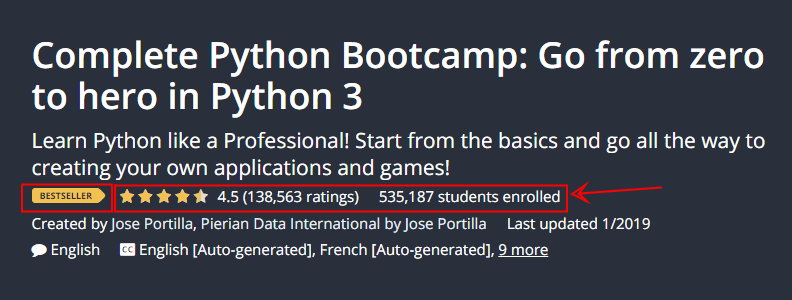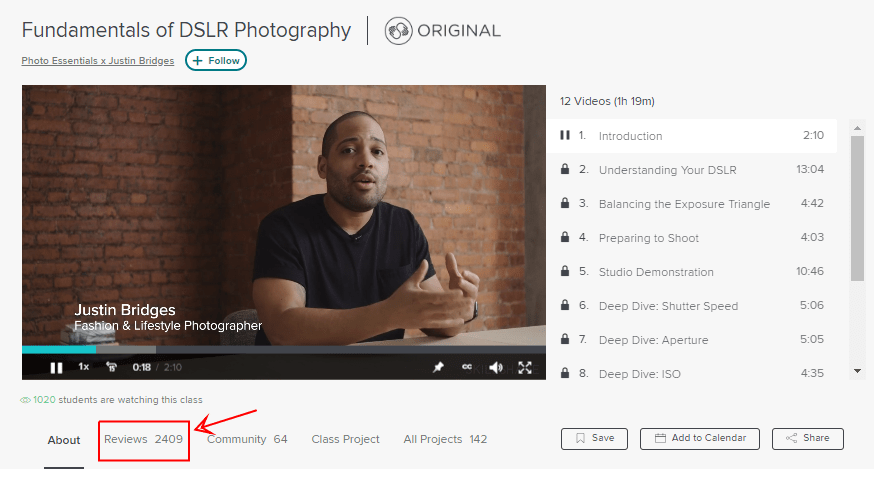Want to step into the next trillion-dollar opportunity? Online learning is one of the hottest emerging industries where you can literally create massive cashflows without needing an office or employees.
All you need is a computer system and internet accessibility to get a tremendous opportunity to learn exciting things. The popularity of eLearning is astonishing. The industry is said to touch 325 billion USD mark by 2025.
College graduates, full-time employees and people with a disability often find college degrees expensive and hard to cope in the long run. Online learning gives flexibility and allows people with a busy schedule to study what they like at their own pace.
There is no rush of completing your course as you can learn in your spare time and from anywhere you like.
77% of researchers believe that online learning has the same or more positive impact on students just like face-to-face learning. So, around 60% of online learners are full-time employees.
If you are also trying to leverage this trend and generate another income source for yourself, here is your guide on how to create an online course.
1. Decide what are you going to teach
The subject becomes extremely important when you are teaching something. You need to set clear objectives and goals about the purpose behind creating your online course.
To begin, first, you can to ask these three questions.
- What am I like?
- What do I know a little more than others?
- How can I make people’s lives better through my skills?
These questions will clear your path of deciding your subject of the course. Answer these question and the common aspects out of these questions will be your final topic.
For example, you like photography the most but haven’t conducted any professional shoot on your own. It’s a possible scenario where you are passionate about the subject but don’t have much knowledge about it.
In another example, you have been a leader in your organization and excellent negotiator when it comes to onboarding a client or managing the human resource in your department. This could be your perfect topic to create your online tutorial series.
Such brainstorming can help you decide what type of online course you should publish.
2. Research the market for your course
This step is very important. Even though you like something very much and also have a great knowledge about the same, you cannot expect people to like it too and start purchasing your stuff. That said, people who are going for eLearning have very high expectations.
You need to understand the demand for the subject’s expertise, know that if there are people who would like to know more about the information, and have the positive intent to buy your lectures.
Say you know everything about kittens – their breeds, their habits, their history and also know how to train them.
It might happen that you would produce some excellent content that might help others raise their pets.
However, you need to understand how many pet owners would happily invest in your course and have got enough time and flexible schedule to watch your chapters and then apply the same in their routine lives.
Do you understand where I am heading?
Even though you know how to train a pet, would it be cost effective for others to actually buy your course instead of sending their kittens to pet school for training?
This way, they can have a job done instead of buying lecture series and applying those tricks.
A good start to research your topic is from Google and search
- learn [your niche] online
- online course [your niche]
- [your niche] online course
Put your industry name in place of [your niche] and hit search. You will get to know all the leading course available online. To know the demand for the course, you can do keyword research to know the monthly search volume of the keyword.
You can use Neil Patel’s Ubersuggest or Google Keyword Planner to begin keyword research.
You can also go to Udemy or Skillshare to search course of your industry. These websites will have ratings and reviews about a particular course through which you can know how successful is a particular course.
Here’s an example of one of the Udemy’s courses!

Here’s an example of a Skillshare’s course!

Ask yourself if you can have better knowledge and have the resource availability to produce a better course.
3. Understand the needs of the users
Before start recording the lectures of your course, you will need rigorous research and thinking about how you are going to develop your content and how you are going to convey your message through lectures.
So, ask these questions before beginning recording?
- What is the level of understanding of my students?
- How busy their schedule would be?
- What might be their occupation and designation?
These questions will help you craft your videos that make sense to the right people. For example, if you are publishing video lectures on “advanced link building techniques”.
You are targeting a specific type of people who are experienced and have an intermediate-to-advanced knowledge of online marketing and SEO.
So, people who do not have any idea about the basics of SEO would not purchase your course.
These questions will give you ideas about your prospects’ routine problems while performing SEO tasks and help you decide how are you going to help them. Because covering basic SEO techniques would not help them and could not align with the title of your course.
You will have to stick to what your users are expecting and convey your message accordingly
Based on the answers, you will get to decide the length of your course and the content you are going to include that would appeal directly to the right prospect and become viral.
4. Write a script and structure your course
Writing script for your lectures will help you what are you going to speak when the camera starts recording. You will know beforehand how to convey your thoughts in a way that your students instantly understand.
If you are not going as per your script, you will end up jeopardizing the structure of your course. The structure will allow you to decide how much chapters you are going to put in your course.

The structure will allow you to think the optimum number of video lectures per chapter and for the course as a whole.
There might be a few points that would need less attention and can be covered in a single video, and there are important tips and tricks that require additional attention.
You can aggregate those points together in a single video and make dedicated video lectures for important points. If you keep adding separate videos for all the areas, the flow of the course and the number of videos will turn-off the users’ attention.
The answers to questions discussed in point 3 will help you structure your course. Keep in mind that in the urge of concise content, you don’t end up concluding your course in a few videos.
Such user experience will lose your credibility and more users might avoid purchasing your course.
Based on the level of viewer’s understand and their current professional circumstances, you should discuss points and write script accordingly.
Writing titles and descriptions about your lectures should be thought out properly. The headline and the description of each video must spike the curiosity in your viewers and make them click your videos to know more.
Your students might like the documentation of the important points of your video lectures.
Along with your video lectures, give your students the study material which they can download afterward to read. You can also add a few surprising lectures that would delight your customers. The more delightful experience you can give, the more sales you will attract.
5. Record videos and edit them
- Do you communicate and teach someone – check
- Do you have enough knowledge and experience to help others? – Check
- Do you have an excellent script and persuasive headline? – Check
- Does your video quality is excellent? No – then your previous hustle won’t work at all.
Your video quality should be supreme and your viewers should get sublime tutorials that give them an excellent and memorable learning experience. The quality of your videos will create the first impressions to your users.
Even though you have some of the match-less information to share with your students, if your videos are not clear and voice is not audible enough, your users will end up getting frustrated.
Always use a dedicated video camera or shoot videos on a DSLR to maintain the quality. Also, have a dedicated mic while speaking and use a tripod to mount your camera.
Moreover, instead of shooting on MP4, always shoot in RAW format to ensure smooth post-production. The RAW format will allow you to flawlessly edit color reproduction while maintaining the core details of the video.
If you know how to edit videos, that’d be great. Otherwise, you can hire a freelance graphic designer. Make sure the focus of the video should be on the subject.

If you are in a frame speaking and teaching, the focus has to be on you. Else, if you are sharing a screen or writing something on board, ensure that the focus should be maintained on them.
While post-processing ensures that the length of your videos should be equivalent to the amount of information you are providing.
No need to stretch your lectures unless you are providing exciting information that won’t lose your viewer’s interest.
If you add unnecessary effects, animations and stretch your videos without reason, your users will feel bored and won’t grab the message effectively for which they have signed up.
Moreover, give them a room for breath while sharing tips and tricks. Immediately shifting to new chapters or points without stopping for a couple of seconds will make your lectures heavy and hard to comprehend.
Your lectures can last from 2 minutes to 20 minutes as depends on what are you trying to teach and how are you teaching.
So, after finalizing your edits and post-processing, show your videos to some relevant audience and get feedback from them. Based on their reviews you can re-edit your videos to get the best version to show to your students.
6. Decide robust marketing and advertising plan
Don’t expect your potential students to find your course on their own and purchase it. To grab more visitors to your course’s landing page and eventually convert them as your students, you need to strategically target and influence them.
You should emerge as an authority and trusted source for the particular field of study of which you are a tutor. The way you project yourself and pitch your course on the web is going to bring profits at the end.
If you have made rigorous market research in step two, you would know what is the current market situation and be psychologically prepared if there is a competition in your niche.
To start promoting your products, your prospects should know that you exist and happen to be a tutor of a niche they are interested in. Hence, you need to reach your prospects where they spending time while using the internet.
Before that, you need to understand where are you going to sell your course; are you going to make your own website where you sell your courses or sign up on Udemy and Skillshare for selling your tutorials.
If you are aspiring to develop your own website, you might have to bear the cost of hosting and domain purchase, website development with SSL security certificate, etc.
You will have to promote your website through search engine optimization, PPC ads, social media marketing, email outreach and so on.
You can try giveaway for promoting your courses to people who have decent following and authority in your industry and request them to write a genuine review. You can ask them to share the review on their social media channels.
This way, you will have more traffic on your product page and hopefully, get more conversions at the end.
Conclusion
Companies can have 218% higher revenue per employee and 24% higher profit margins if they include eLearning, a survey found. Not only individuals but companies too are keenly looking for a resourceful online course to educate their workforce.
The steps discussed above will able to help you plan, strategize, execute and promote your online course and make it an asset for your business activities.
Register for my next webinar where will teach you how to build your own eLearning business.

1 Response to "How to Create an Online Course Which Sells Like Hot Cakes"
HELLO Siddhart!
Thank you for sharing immense knowledge on this page, but the execution practically still requires something more than this.
Being an English educator for over 2 decades, I now want to monetize my knowledge through online spoken English (only for ladies). What are the best ways to market my business, catch students & convert them? (other than my known ones on social media). I have purchased Graphy software too & conducting online classes. Please suggest.